40 Cheap and Easy Ways to Fill Your Raised Garden Beds
Are you looking for easy, cheap ways to fill your new raised garden beds?
If so, you’ve come to the right place because I’ve installed 8 raised beds in my backyard, and I’ve filled them up with all manner of materials that have saved me money and created wonderful, healthy soil over time.
The cheapest, easiest ways to fill raised garden beds is with compostable materials, leaving 6-8 inches at the top for garden soil and mulch. Logs, branches, cardboard, flowers, grass clippings, kitchen scraps, leaves, livestock manure, straw, and wood chips are all ideal for new raised beds.
But let me be clear about something: You can’t just dump things in and hope for the best.
You’ve got to have a plan for how you’ll layer your materials so as to encourage the decomposition process.
You also need to think about the kinds of plants you want to grow that first year since at least 50% of your raised beds will be filled with materials that haven’t yet composted and thus won’t support long-rooted plants.
What I want to do in this article is to share all that I’ve learned when it comes to filling new raised garden beds cheaply and easily, including short summaries of my preferred materials plus tips and tricks to get the most out of your raised beds in both the first year and beyond.
But before we get to the summaries, here’s an alphabetized list of the materials that I’ve put in my raised beds at one point or another:
As you can see, there’s lots of options, but if you’re not careful, you can make mistakes along the way.
Keep reading to learn the ins and outs of filling raised garden beds cheaply and easily!
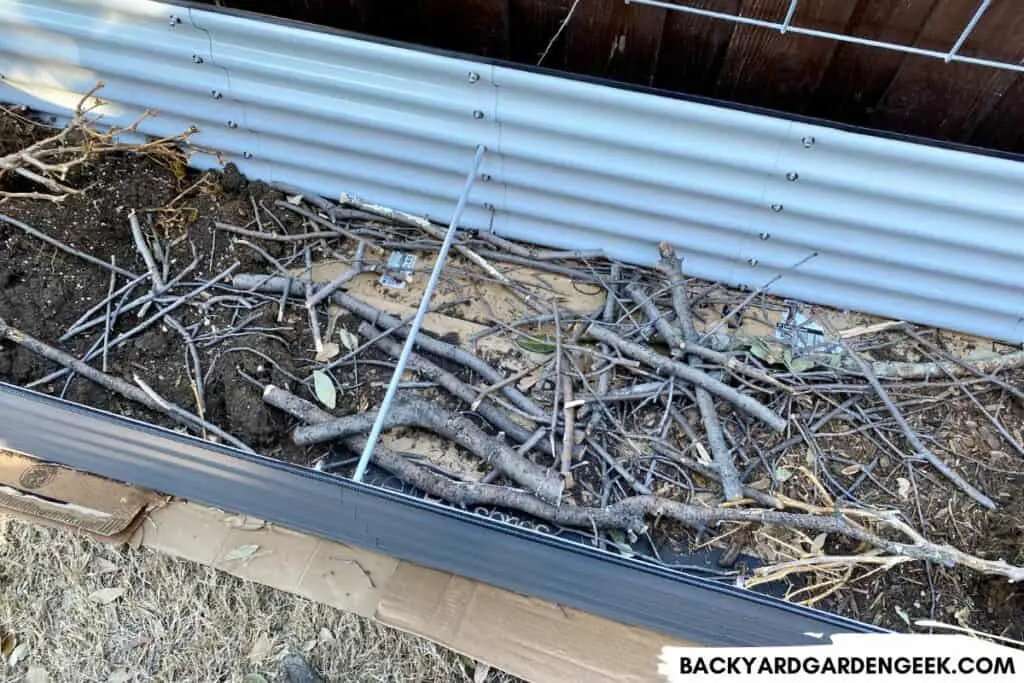
40 Free or Cheap Things to Put in Your Raised Garden Beds
When you read the list below, here’s what I don’t want you to do when setting up your raised beds: Don’t just grab stuff and toss it in to fill up all of the available spaces.
In this article in my favorite 18 things to put in the bottom of raised beds, I explain my layering process in great detail, which is similar to hugelkultur or lasagna gardening.
But here’s a quick overview of what I do:
- Mentally divide your new garden bed into 4 layers in terms of depth: the bottom 25%, the lower middle 25%, the upper middle 25%, and the top 25%.
- In the bottom layers (Layers 1 and 2), put anything that’s compostable but that’s larger and needs more time to break down.
- In the upper layers, make sure there’s plenty of mature compost and soil since you likely want to start gardening right away in your new raised beds.
- If you don’t plant to garden in the beds for at least a year, go ahead and fill them mostly with compostable materials, then top them off with 1-2 inches of soil and 1-2 inches of mulch or wood chips. As long as worms and microorganisms have access to the bed, they’ll aid greatly in the decomposition process, and a year from now, you’ll have a bed that’s ready to plant in.
Now that we’ve covered some basics, I’d like to provide some detailed thoughts about the list I shared above so that you can make informed decisions on whether or not to add those materials to your raised beds:
You’ll notice below that I put the letters “B” and “G” next to each material. Those stand for “Brown” and “Green,” and when you’re building a raised bed, it’s always nice if you can mix browns and greens into your layers because browns will release carbon as they decompose while greens will release nitrogen.
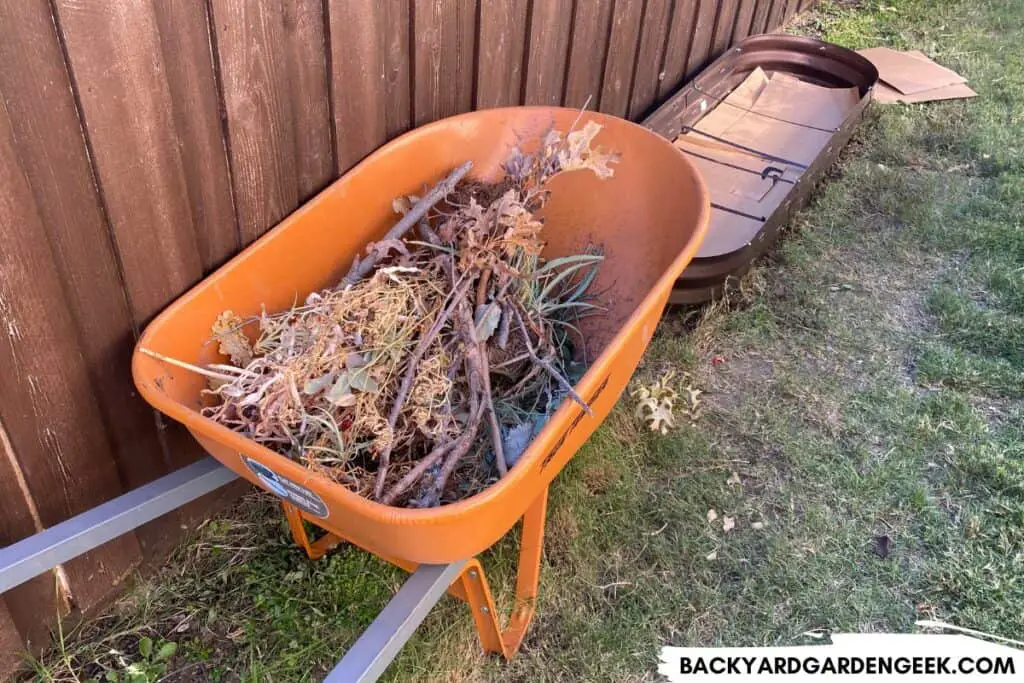
Just know that, given enough time, it’s certainly not necessary to layers browns and greens, but it’ll definitely help you build raised beds that have more balanced, healthy soil in them.
So here’s my complete list, with some things to keep in mind listed next to each kind of material:
| Material | B/G | Recommendations |
|---|---|---|
| Banana Peels | G | They’re not as magical as some bloggers imply, but they’ll help your soil as they decompose. |
| Branches | B | Put larger branches in the bottom. They’ll decompose nicely in 8-12 months. |
| Cardboard | B | Place this underneath your garden bed in several thick layers. It’ll kill off grass and weeds. |
| Compost | B | A perfect addition to a raised garden bed! |
| Egg Cartons | B | Put cardboard egg cartons in the bottom of your raised beds. They’ll decompose in 6-8 months. |
| Eggshells | G | You can add these to Layers 1-3 since they’ll disappear in 2-3 months. |
| Fish Scraps | G | They’re great for helping tomatoes and peppers. |
| Fruit Scraps | G | You can literally add as much of this as you have. It’ll decompose in weeks. |
| Christmas Trees | B/G | Installing a new bed after Christmas? Chop up your natural tree and put it in the bottom! |
| Coffee Filters | B | Paper filters decompose quickly. Throw them in! |
| Coffee Grounds | B | Don’t mix new coffee grounds in upper layers. But they’ll do great as time goes on. |
| Dead Houseplants | G | I always toss dead plants in the bottom of my beds (as long as they weren’t diseased). |
| Flowers | G | Dead flowers will decompose in no time at all! |
| Garden Plant Scraps | G | Have scraps from your garden? As long as the plants weren’t diseased, you can toss them in your new raised beds. |
| Grass Clippings | G | Be careful with grass. Never add Bermuda (or other rhizomatic grasses). Never add grass that was treated or had seed heads on it. |
| Hay | B | Perfect for raised beds. Just be sure you trust the source because hay has sometimes been treated with chemicals. |
| Jack O’Lanterns | G | Have a raised bed that needs filling in November? Toss that jack o’lantern in there! |
| Junk Mail | B | This will work. Just be careful. You’ll want to avoid plastic and dyed paper products. |
| Kitchen Scraps | G | These are the absolute best for raised beds. Just make sure they’re all compostable. |
| Leaves | B | This is my favorite way to get rid of unwanted leaves on my property. |
| Livestock Manure | G | Livestock manure only, and you must put new manure in the bottom layers. It needs time to decompose before your plants get to it. |
| Logs | B | One of the best ways to fill up the bottom of raised beds. They’ll need lots of time to compost. |
| Loofahs | G | Add natural loofahs to raised beds. Don’t put synthetic ones in there! |
| Mulch | B | Be careful with mulch. If it’s dyed, make sure the dyes are natural/organic before adding to raised beds. |
| Newspaper | B | Only black and white newsprint. I avoid colored dyes. |
| Paper Documents | B | Same as above. Black and white paper documents only. |
| Paper Napkins | B | Add old napkins only if they’re paper, clean, and non-dyed. |
| Paper Towers | B | Paper towels will decompose quickly. |
| Pet Fur | B | Only put fur in the very bottom of raised beds. It’ll need time to decompose. |
| Pine Needles | G | Much like leaves, these are great for filling up raised beds. |
| Potting Soil | G | This is a great way to use old potting or gardening soil! |
| Rope or Twine | B | You can put natural rope and twine in the bottom of raised beds. No synthetics! |
| Straw | B | Like hay, straw is good for raised beds. You can even mulch your beds with it. |
| Sticks or Twigs | B | Much like branches, these are great. But they’ll decompose faster than larger branches since they’re often smaller. |
| Table Cloths | B | Only add if they’re paper and non-dyed. Otherwise, trash them. |
| Tea Bags | B | These are fine, but you’ve got to remove staples before doing so. |
| Tea Leaves | G | Perfect addition to raised beds! |
| Toilet Paper Rolls | B | No used toilet paper please! But leftover rolls can be added with other cardboard. |
| Wine Corks | B | Only natural cords. Don’t add synthetic ones. |
| Wood Chips | B | I love filling the bottom of beds with lots of wood chips. Just make sure to mix in some greens as well. |
Now that I’ve provided a complete breakdown of all of the materials that I’ve placed in the bottom of raised beds at one point or another over the past 15 years, here’s a layer-by-layer breakdown of which materials I put in each layer.
I’m assuming here that your beds are deep enough to fill up with scraps while also leaving room at the top for growing short-rooted plants the first year.
I’ve got 8 raised beds in my backyard (as well as a concrete block garden bed), and they’re all at least 12 inches deep.
You can fill deeper beds with more materials, especially larger materials like logs, chopped up Christmas trees, and large branches.
If your beds are shorter, follow the general advice above and below, but please take into account that there’s less space overall for putting materials in your raised beds.

Whatever the depth, I like to fill the top of my new raised beds with 6 inches of soil. That way, I can immediately begin gardening by filling those raised beds with short-rooted plants such as arugula, beets, kale, lettuce, and all kinds of herbs, to name a few.
Layer 1: The Bottom 25% of the Raised Bed
- Branches
- Cardboard
- Christmas Trees (chopped up)
- Dead Houseplants
- Grass Clippings (untreated + without seed heads + never Bermuda)
- Hay
- Jack O’Lanterns
- Junk Mail (all plastic removed)
- Logs
- Pet Fur
- Rope or Twine (natural only, no synthetic)
- Sticks or Twigs
- Straw
- Toilet Paper Rolls
Layer 2: The Lower Middle 25% of the Raised Bed
- Banana Peels
- Egg Cartons (cardboard only)
- Coffee Filters (paper only)
- Coffee Grounds
- Flowers
- Garden Plant Scraps
- Kitchen Scraps (anything that’s compostable)
- Leaves
- Livestock Manure (chicken, cow, goat, horse, llama, sheep)
- Loofahs (natural only)
- Mulch (preferably non-dyed kinds)
- Newspaper (black and white, no colors)
- Paper Documents (plain paper only)
- Paper Napkins
- Paper Towers
- Pine Needles
- Sticks or Twigs
- Tea Bags (paper only, no staples)
- Tea Leaves
- Wine Corks (natural only, no synthetic)
- Wood Chips
Layer 3: The Upper Middle 25% of the Raised Bed
- Compost
- Eggshells
- Fish Scraps
- Fruit Scraps
- Coffee Grounds
- Garden Plant Scraps
- Kitchen Scraps (anything that’s compostable)
- Potting Soil (used in last year’s containers)
- Rope or Twine (natural only, no synthetic)
- Straw
- Table Cloths (paper only, no dyes)
- Tea Bags (paper only, no staples)
- Tea Leaves
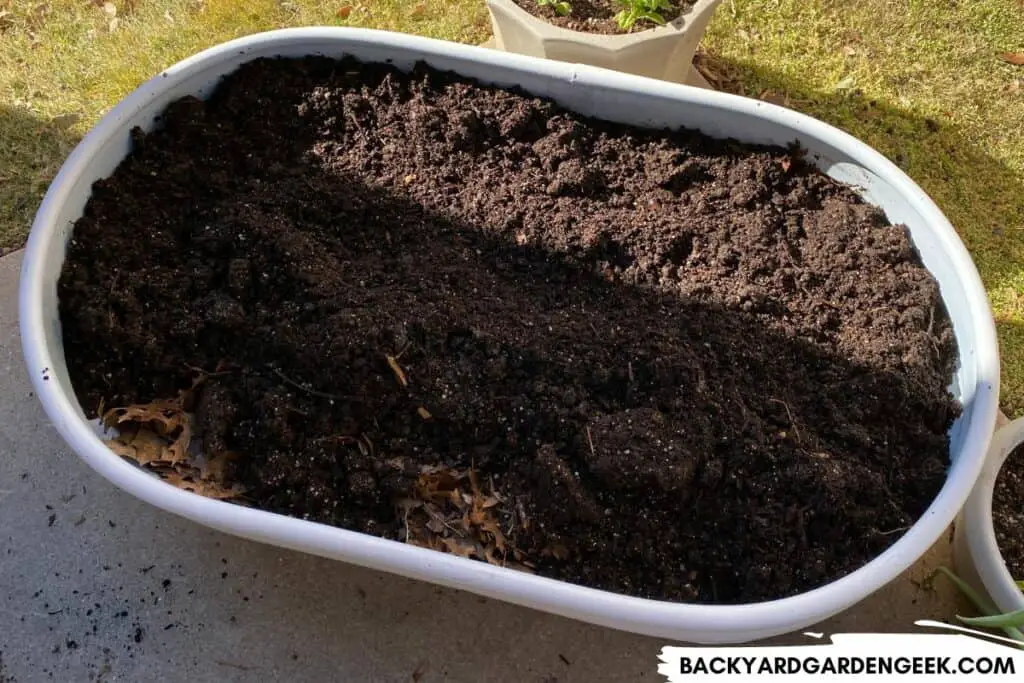
Layer 4: The top 25% of the Raised Bed
- Compost
- Garden Soil
If you’ve made it this far, you now know about 40 different materials you can use to fill up your raised beds cheaply and easily!
I hope this will encourage you to build more raised beds in your backyard and put all kinds of things in them instead of merely tossing those materials in the trash.
And if you’re willing to wait to garden in your new raised beds, you can fill them up nearly to the top with materials that’ll cost you next to nothing, then cover with some soil or compost and let nature run its course.
In 10-12 months, you’ll be able to dig into the bed and find lots of amazing soil!
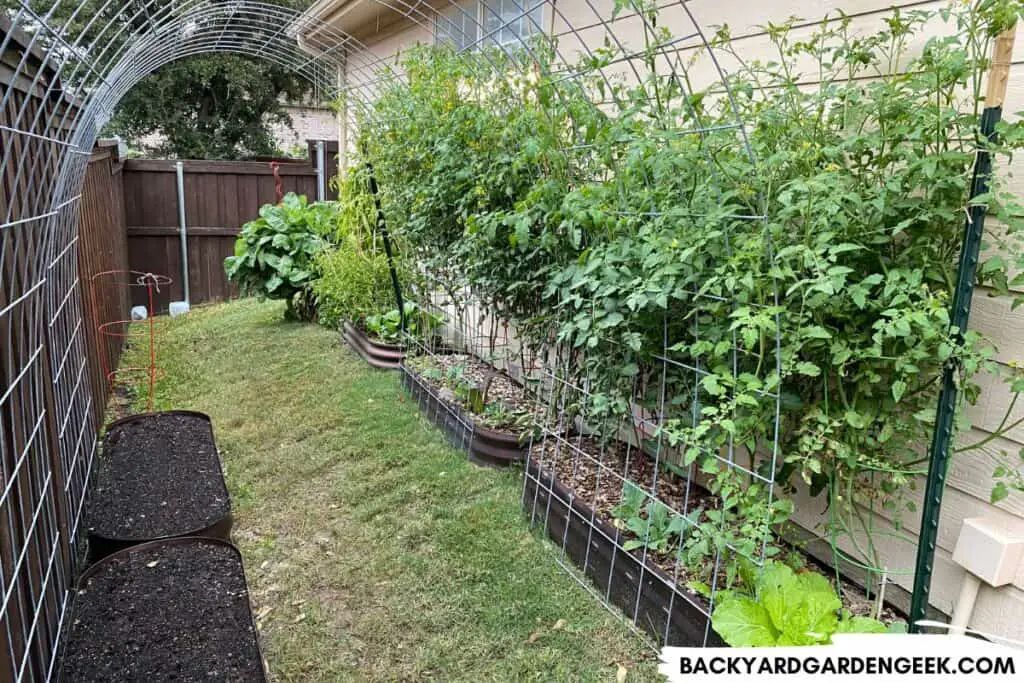
Want to Learn More?
I love my raised garden beds, but there’s a lot to keep in mind when you’re just starting out.
If you want to read more how to make sure your raised beds are set up properly, take a look at these related articles:
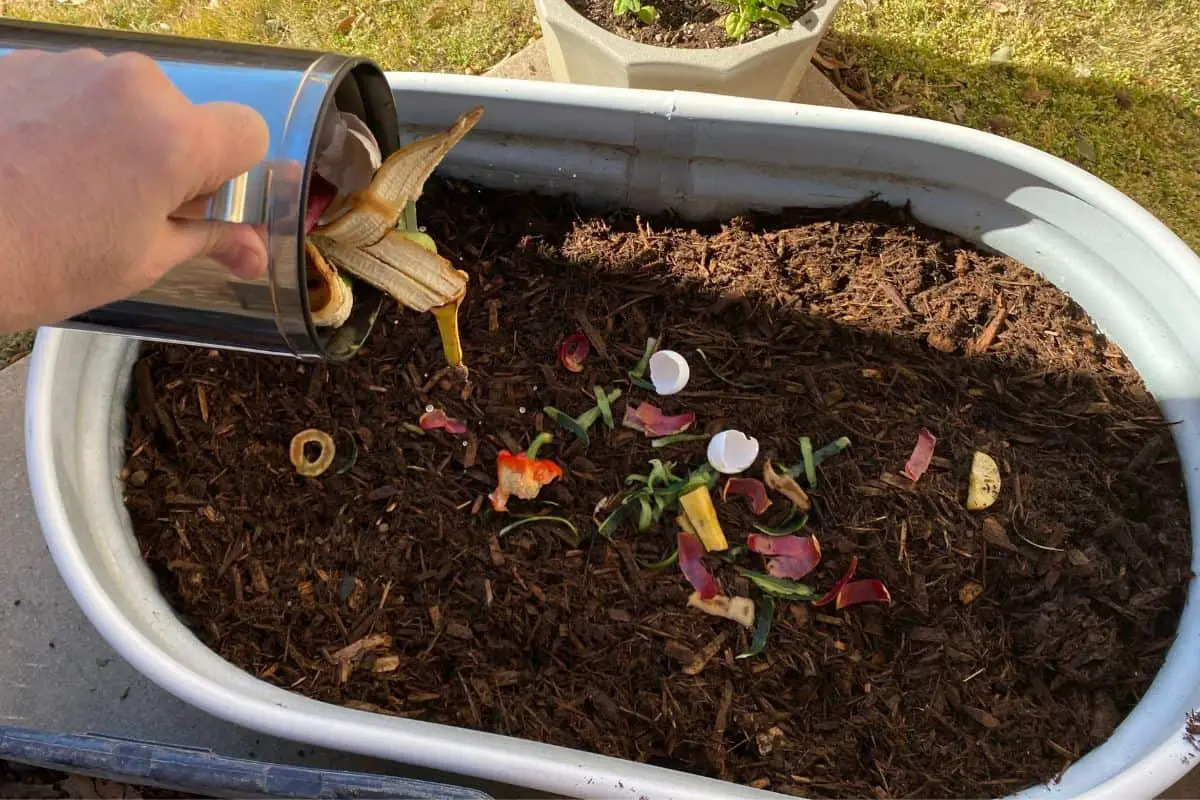
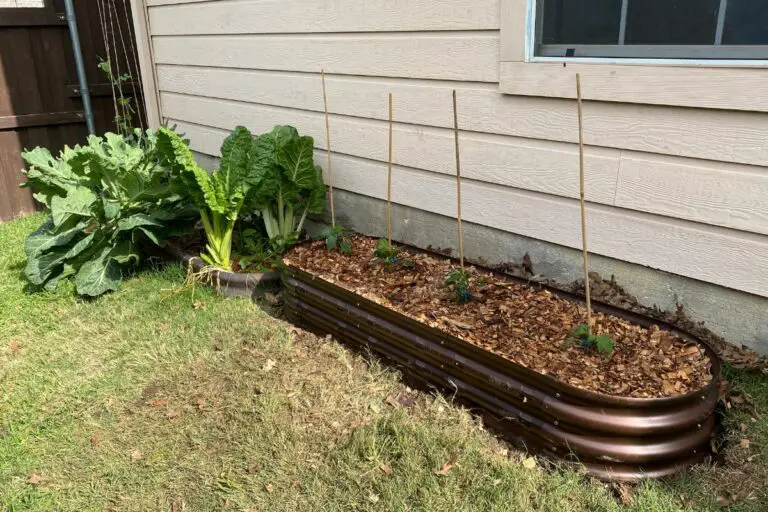

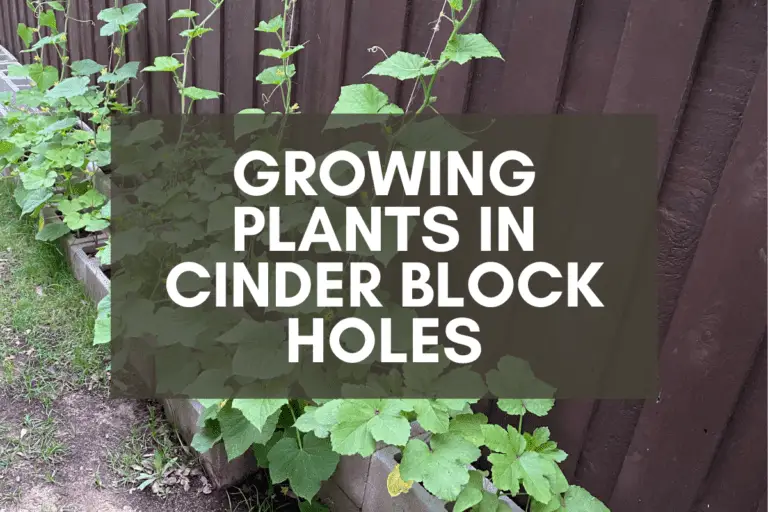
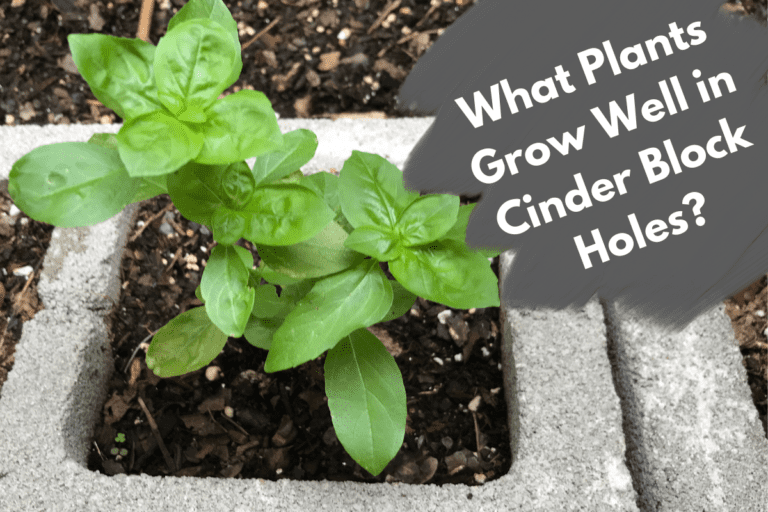

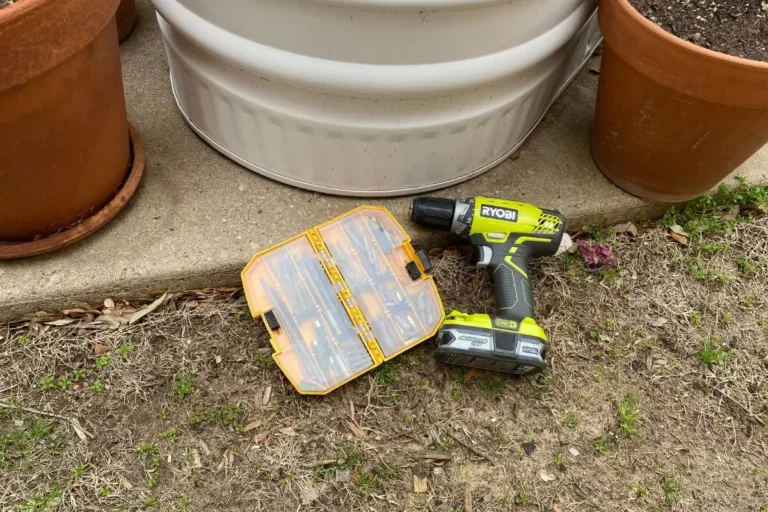
I have new beds 22″deep, I want to start planting this year. Can I use your 4 layers with 25% each as described and plant this year?
With a 22″ deep bed, you’ll want to use the same general idea, but make sure you leave at least 10 inches on top (7-8 for soil, another 2-3 for a nice mulch covering). That way, you can grow veggies in that bed this year–such a lettuce, spinach, and other short-root plants–and by next year, you’ll be able to garden using the entire bed. If you want to grow long-root plants such as tomatoes and peppers, take one of those cheap plastic pots from the garden center, cut out the bottom, and put it in your bed while filling the rest. Fill around the pot, then fill the pot with soil only and put your tomato or pepper plant in there. Once it’s nice and firm, wiggle the pot to pull it out of the bed and press everything down around the edge. Now your plant has plenty of soil to grow in this first year!